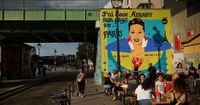Paris has recently unveiled a striking new mural honoring the enduring legacy of Josephine Baker, the iconic U.S.-French entertainer and civil rights activist. Painted by urban artist FKDL, the mural now watches over a vibrant and diverse neighborhood in northeast Paris, symbolizing freedom and resistance. This artistic tribute comes exactly fifty years after Baker's death in 1975, reaffirming her profound impact on both French culture and the global fight against racial injustice.
The mural was revealed to the public on Saturday, July 19, 2025, during a street art festival organized by the association Ourcq Living Colors. This festival aims to promote community spirit through art, and FKDL’s work is a centerpiece of the initiative. FKDL, known for his focus on bringing women back into the urban landscape, described Baker as “an extraordinary character, an incredible woman,” embodying both wildness and free-spiritedness, deeply connected to music, musicals, and dance.
Josephine Baker’s story is one of remarkable resilience and trailblazing achievement. Born in St. Louis, Missouri, in 1906, Baker rose to megastar status in the 1930s, especially in France, where she moved in 1925 to escape the harsh realities of racism and segregation in the United States. Her decision to relocate was not just a career move but a profound personal statement against the systemic inequalities she faced at home. In France, she flourished as a performer, captivating audiences with her charisma and talent.
Beyond her stage success, Baker’s legacy is deeply intertwined with her courageous role during World War II. She served as a spy for the French Resistance, risking her life to gather intelligence against the Nazis. Her bravery extended beyond wartime, as she also marched alongside Martin Luther King Jr. in Washington, advocating for civil rights and equality.
The mural’s unveiling was a poignant moment for Baker’s family, particularly her son Brian Baker. He was present to witness the tribute and expressed his emotions candidly, saying, “I feel moved and I feel happy because this is part of a memory of my mother.” Brian is one of twelve children Baker adopted from around the world, whom she affectionately called her “rainbow tribe.” This unique family symbolized her commitment to diversity and unity, reflecting her belief in a world without racial barriers.
Josephine Baker’s influence continues to be recognized in France and beyond. She holds the historic distinction of being the first Black woman inducted into France’s Pantheon, an honor reserved for the nation’s most revered figures, including philosopher Voltaire, scientist Marie Curie, and writer Victor Hugo. This induction cements her place not only in cultural history but also as a symbol of resistance and progress.
The mural itself is part of a larger wave of street art in the neighborhood, all organized by Ourcq Living Colors, which seeks to invigorate the community with images that celebrate freedom, diversity, and resilience. The choice to depict Baker gazing over the area is deliberate, evoking her enduring watchfulness and connection to the city she called home.
FKDL’s artistic vision captures the essence of Baker’s multifaceted identity: a performer, a freedom fighter, a mother, and a symbol of hope. His work invites passersby to reflect on her life and the values she championed. It also underscores the power of public art to keep history alive in the everyday lives of city residents.
As Paris embraces this new mural, it reaffirms its commitment to honoring figures who have shaped its cultural and social fabric. Josephine Baker’s legacy, from her dazzling performances to her fearless activism, continues to inspire generations. The mural stands not just as a tribute to a legendary artist but as a beacon of the values she lived for—freedom, resistance, and the celebration of diversity.
In a world still grappling with issues of race and equality, the mural serves as a timely reminder of the progress made and the struggles that persist. Josephine Baker’s life story, immortalized in this vibrant artwork, challenges us to remember the past while striving for a more inclusive future.
Her son’s words encapsulate the sentiment surrounding the mural: “My mother wouldn’t have liked words like iconic, star, or celebrity. She would have said, no, no let’s keep it simple.” And perhaps that simplicity—of love, courage, and unity—is the most powerful legacy of all.


